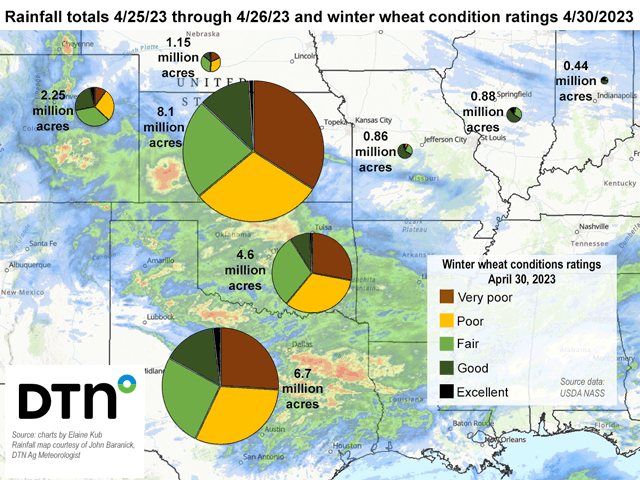Kub's Den
The $2 Billion Rain That Came Too Late
If the precipitation that fell a week ago in the Southern Plains had come a month earlier, I think it could have confidently been called a "billion-dollar rain," or, more accurately, a $2.6 billion rain. With over half an inch falling over two days across most of Oklahoma, and over 4 inches blessing a nice pocket of southwestern Kansas, it could have saved a winter wheat crop that has faced nearly every adversity possible -- droughty conditions during fall emergence, freeze events while coming out of dormancy, and even extreme wind and dust sandblasting the nascent plants.
Just for the sake of arithmetic, if all of Texas' 6.7 million acres planted to winter wheat in 2023, plus all of Oklahoma's 4.6 million acres, plus all of Kansas's 8.1 million acres, had received a rain event sufficient enough to boost yields by 18 bushels per acre (bpa), then the economic value of that rain would have been equivalent to 349.2 million bushels (mb), or about $2.6 billion, with July KC wheat futures currently around $7.50 per bushel.
It's not too much of a stretch to wonder if a timely April rain could have added 18 bpa to each drought-hit state's winter wheat yield. A 2011 study (https://acsess.onlinelibrary.wiley.com/…) by K-State researchers analyzed 56 years of real-world conditions and winter wheat yield data and concluded that fall precipitation is the most important factor to increase yield, followed by spring precipitation. Precipitation past a certain point in May doesn't improve yield but can help improve test weight. Historically, the near-ideal water conditions of irrigated winter wheat have given it an 18-bpa boost over non-irrigated winter wheat in Kansas. Therefore, we can wonder how the 2023 winter wheat crop would have been different without the exceptional drought looming over half of Kansas -- would it have been the difference between 32 bpa and 50 bpa on good field? Or would it have been the difference between 18 bpa and 0 bpa on the fields that will now get abandoned, tilled under and planted to some other crop?
Another insight from the 2011 K-State study showed that an average freeze event in Kansas can damage winter wheat yield by at least 8 bpa, and the evidence in the weekly crop progress report is suggesting this sort of damage from recent low temperatures has been more prevalent than any improvement from last week's rain. Kansas' winter wheat condition ratings actually fell week over week in Sunday night's observations, with another 2 percentage points dropping from the poor category into the very poor category (equivalent to 162,000 acres). Oklahoma's conditions fell, too: going from 28% rated very poor on April 23 to now 32% rated very poor.
P[L1] D[0x0] M[300x250] OOP[F] ADUNIT[] T[]
WINTER WHEAT CONDITIONS
| KANSAS | April 23 | April 30 |
| Very poor | 32 | 34 |
| Poor | 30 | 30 |
| Fair | 24 | 23 |
| Good | 12 | 12 |
| Excellent | 2 | 1 |
| OKLAHOMA | April 23 | April 30 |
| Very poor | 28 | 32 |
| Poor | 33 | 31 |
| Fair | 30 | 31 |
| Good | 8 | 6 |
| Excellent | 1 | 0 |
| TEXAS | April 23 | April 30 |
| Very poor | 26 | 24 |
| Poor | 31 | 31 |
| Fair | 26 | 31 |
| Good | 15 | 13 |
| Excellent | 2 | 1 |
So, what to do now? Plenty of winter wheat acres in the Southern Plains have already been zeroed out as insurance claims and tilled under to be ready for the next thing. But there are obviously some fields still limping along and being observed in their very poor condition. Will last week's rain be enough to make hope worthwhile? There are more showers forecast to come again later this week, after all.
But, as DTN Ag Meteorologist John Baranick emphasized to me, that forecast is for "scattered" showers -- nothing certain for any particular area. "If a farmer is teetering on the edge about this decision, it would be a big risk to keep the crop at this point. It's not like we're guaranteeing another 2 to 4 inches of rain. But it's not like there's no chance. It's a really tough call, and each individual's decision."
The weekly crop progress report may have showed some evidence that many of these decisions have already been made, to the detriment of winter wheat production and toward the direction of more corn production in Kansas in 2023. The state's intended corn acres suddenly went from 24% to 34% planted in one week between the April 23 crop progress observations and the April 30 observations. The bigger question, of course, will be just how many acres end up in each crop by the time harvest rolls around.
**
Comments above are for educational purposes only and are not meant as specific trade recommendations. The buying and selling of grain or grain futures or options involve substantial risk and are not suitable for everyone.
Elaine Kub, CFA is the author of "Mastering the Grain Markets: How Profits Are Really Made" and can be reached at masteringthegrainmarkets@gmail.com or on Twitter @elainekub.
(c) Copyright 2023 DTN, LLC. All rights reserved.



